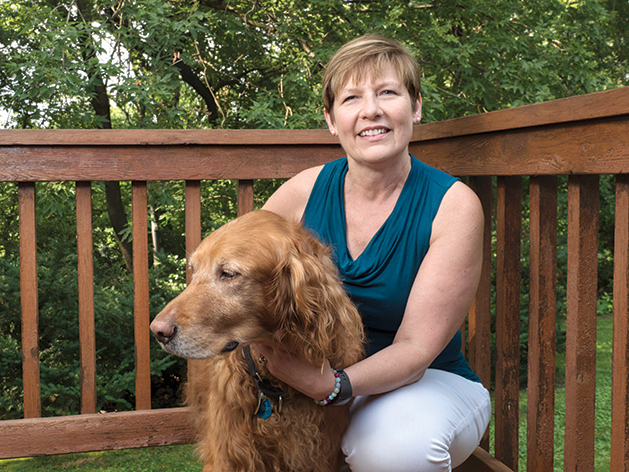
“My biggest concern was not that I might die of this disease, but how was I going to live with it for as long as I could have?” Minnetonka’s Teri Woodhull says in the opening of a video for the American Association for Cancer Research (AACR).
Diagnosed in 2010 with advanced ovarian cancer, Woodhull’s medical journey took her through surgery, rounds of standard treatment and clinical trials, including one being conducted at Sutter Health in San Francisco.
Today, Woodhull’s cancer remains stable, thanks to her participation in a clinical trial testing the targeted therapy niraparib. That trial led to the drug’s approval by the Food and Drug Administration (FDA) in March 2017. Woodhull remains in the trial, as outcomes are still being tracked.
Woodhull’s story begins long before she was born. At some point in time, the BRCA1 mutation settled into her family’s bloodline. “Specific inherited mutations in BRCA1 and BRCA2 increase the risk of female breast and ovarian cancers, and they have been associated with increased risks of several additional types of cancer,” according to the National Cancer Institute. “Each child of a parent who carries a mutation in one of these genes has a 50 percent chance of inheriting the mutation.”
Breast cancer affected Woodhull’s great-grandmother, grandmother and cousin. At 46, her mother died from breast cancer. In 1993, Woodhull underwent a bilateral prophylactic mastectomy in hopes of placing up a roadblock to cancer even before she knew she had the BRCA1 mutation, which was identified in 1994.
After Woodhull was first diagnosed with ovarian cancer, her treatment included a standard course, involving surgery and chemotherapy, and she participated in a clinical trial. When the cancer returned in 2014, more surgery and chemotherapy were done.
After the second round of treatment, tests revealed the cancer remained, and it propelled Woodhull on a mission to find another answer. “I call it my Scandinavian stubbornness,” she says. “I knew there was a better option out there.” After finding Sutter had a spot available in its trial, Woodhull had just days to get her medical records in order and fly to California to determine if she was a fit for the program. She was, and monthly visits to John Chan, M.D., to receive niraparib and CT scans every 12 weeks have halted the cancer’s progression. “It’s certainly been worth it,” she says. There is a misconception, Woodhull says, that clinical trials are a last resort. “They really are, in some cases, the cutting-edge treatment,” she says.
While Woodhull, now a patient advocate with the Minnesota Ovarian Cancer Alliance and Facing Our Risk of Cancer Empowered, feels encouraged by niraparib’s results, she’s also gratified by the FDA’s approval of it, allowing other women to receive the treatment, too. She feels fortunate to have the financial means to defray some of the associated costs of the trial and her family’s support through the process. “In some ways, I feel it’s an obligation,” she says. “It’s a bit of a way to be able to give back.”
Woodhull says comparing niraparib to chemotherapy is like “night and day.” Being on the new drug has “allowed me to live with ovarian cancer,” she says. While there are side effects, including anemia and fatigue, and a suppressed immune system, Woodhull has been able to, with some modifications, conduct her day-to-day life, travel internationally and participate in family events with her husband, Duncan, and adult children, Alex and Amanda.
Woodhull’s progress hasn’t gone unnoticed, and the AACR asked her to be a part of its annual cancer progress report. In addition, she was part of a Congressional Briefing and met with members of Minnesota’s congressional delegation to urge continued support for funding cancer research.
Since 2014, the FDA has approved three PARP inhibitor drugs, including niraparib. “I think that speaks volumes to the progress being made,” Woodhull says. But progress comes at a price, and it requires research dollars, and a cure can’t come soon enough. “It took 27 years after [my mom’s] death for me to have access to [niraparib],” she says. (In general, it can take 20 years for a drug to go from concept to FDA approval.) As Woodhull said at the Congressional Briefing, “I don’t want us to go another 27 years and have my daughter [who has the BRCA1 mutation] standing before your kids and saying the same thing.”









